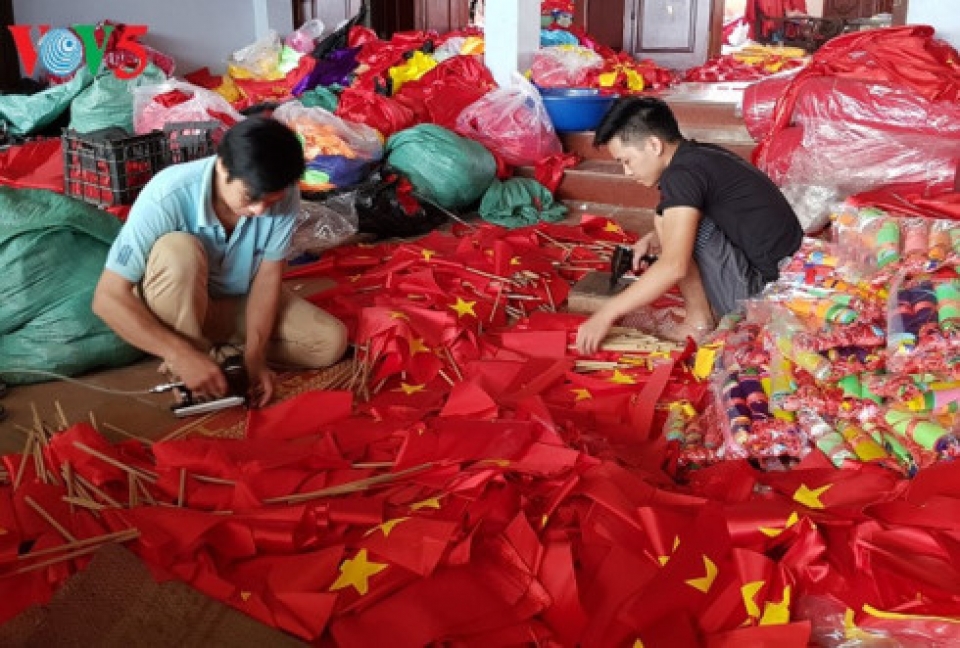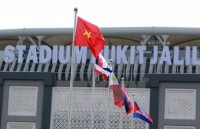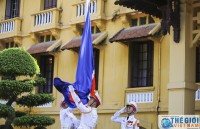
Tu Van, flag making village in Ha Noi
Latest
| TIN LIÊN QUAN | |
| Ha Noi hosts flag-raising ceremony to mark ASEAN establishment | |
| Dong Van – An attractive destination in Ha Giang Province | |
On September 2, 1945, tens of thousands of red flags with a gold star blanketed Ba Dinh Square where President Ho Chi Minh read the Declaration of Independence. Most were made by Tu Van villagers.
 |
According to village elders, Tu Van village has been famous since the 16th century for embroidery and weaving. At that time, many of the villagers opened shops in Hanoi to sell their products. Before the general uprising in August, 1945, craftsmen were asked to make national flags, and many were employed by the Co Do (Red Flag) co-operative in Hanoi’s Hang Bong Street to make flags. This historic moment marked the establishment of Vietnam’s garment industry in Tu Van village.
The fabric used to make national flags is muslin from La Khe in Hanoi’s outlying district of Ha Dong. Other parts of the flag come from Trieu Khuc village.
Nguyen Van Phuc, the owner of a sewing workshop in Tu Van, said, “The village has 10 families engaged in flag production. Some specialize in embroidery. Some tailor national flags for new academic years, National Day celebrations, banners, and posters for major festivals and holidays, and for cheering on the Vietnamese national football team. I have followed my father’s craft. In the past, it took a long time to tailor a flag because they were all hand-made. Sometimes we couldn’t keep up with demand. Now the production process has been automated and programmed so accuracy and productivity are very high.”
Although making national flags doesn’t require much skill, the tailors need to be meticulous in their work to make sure each flag accords with state regulations. Each step requires thorough attention.
Nguyen Thi Thao, a Tu Van flag maker, said, “First it’s necessary to choose good fabric and then cut it to the flag’s dimensions. There are several steps, but the most important step is matching the star to the flag. It must be precisely in the middle. One day I make close to 300 flags.”
Though there aren’t that many families in the village making flags, the trade provides them a steady income and a chance to demonstrate their patriotism and national pride.
Phuc said, “Many state agencies have ordered my family to make national flags. I was invited to make a 54m2 flag to be hung on the Lung Cu flag pole in Vietnam’s northernmost province of Ha Giang. The number 54 represents Vietnam’s 54 ethnic groups. It had to be beautiful yet durable, because it is hung on a hill where the wind is very strong. I am a member of the village’s Craft Association, where people can share their professional experience with each other. We are proud of our products, which are as beautiful as the flags from other countries.”
National flags made by Tu Van villagers are sold in shops throughout Vietnam.
 | Vietnamese flag flies at SEA Games 29 A Vietnamese delegation to the 29th Southeast Asia Games (SEA Games 29) took part in a flag-hoisting ceremony held at Bukit Jalil National Stadium in ... |
 | Flag hoisting ceremony marks ASEAN’s 50th anniversary An ASEAN flag raising ceremony celebrating the bloc’s 50th founding anniversary (August 8) was held in Ha Noi at 7:30 am today. |





















